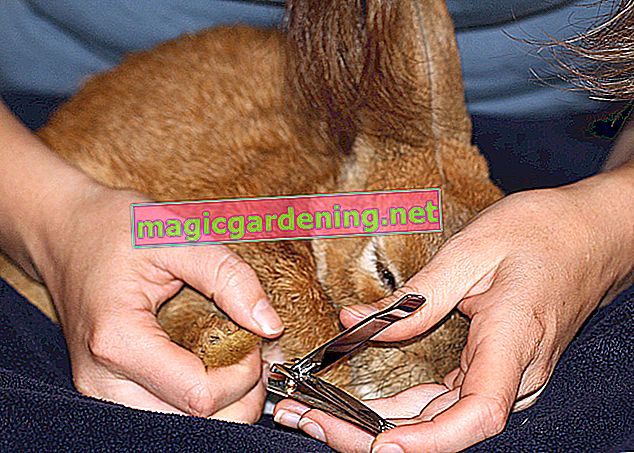
the essentials in brief
- Orphaned hedgehog babies urgently need help; they need a lot of warmth and have to be fed puppy replacement milk in a syringe for the first few weeks of life
- Baby hedgehogs in a nest should not be touched unless the mother does not return after more than two hours
- Initially, the baby hedgehogs also have to be fed at night; Nocturnal feedings can only be omitted from a weight of 100 grams
- The intestines of baby hedgehogs need to be stimulated after feeding so that the baby hedgehogs urinate and feces
What to do with a baby hedgehog
Orphaned hedgehog babies in the garden can get hypothermic very quickly if they are outside the nest. They need protection and warmth from their mother, which is why you should urgently help these hedgehog babies. You can carefully nurse the animals so that the hedgehog babies regain their strength.
also read
- This is how hedgehogs overwinter in your garden - tips for the right winter quarters
- Do wasps help against boxwood moth?
- Do scented geraniums help against wasps?
| body | eyes and ears | Weight | |
|---|---|---|---|
| after birth | pink skin without fur, white spines | closed | 12 to 25 grams |
| first week | pink skin without fur, single dark spines | closed | 30 to 50 grams |
| second week | gray skin with some fluff, dark spines | open slowly | 60 to 80 grams |
| third week | Skin with light fur | open | 100 to 130 grams |
| fourth week | thick fur | open | 140 to 180 grams |
When a baby hedgehog needs help
Around 80 percent of all hedgehog babies in Germany are born between August and September. There are earlier hedgehog litters in June and July in warmer regions such as Saarland or the Rhine Valley. Up to the age of 14 days, the infants still have closed eyes and ears. They are suckled by their mother until they are six weeks old, and they can go without food for up to six hours.
- Do not immediately pick up motherless hedgehogs in the nest
- intervene if mother does not come back after two hours
- Noisy babies outside the nest need urgent help
Hedgehogs are wildlife and should only be included if they really need help.
First aid

Line a box of towels. You can put a hot water bottle between the towels so that the helpless hedgehog children are well warmed. Check the water temperature regularly and replace it as soon as the temperature drops. If the hedgehog gets too warm, there should be enough space in the box to crawl away from the heat source.
Can I raise baby hedgehogs?
Raising a baby hedgehog until it can survive on its own in nature is not easy. Depending on the age and number of babies, they need different amounts of attention. If you are not confident enough to do this, you should turn to a hedgehog rescue center. Note that the stations can be very crowded, especially in autumn. NABU and LBV will help you with any questions about hedgehog babies. In an emergency, you can also contact the nearest veterinarian.
Statutory Regulations
In Germany it is generally forbidden to deliberately alarm or capture animals of the specially protected species. The hedgehog is one of these species and cannot be included without a reason. If the animal is clearly in need of help, the regulations allow an exception. Injured and sick hedgehogs or orphaned hedgehog babies can be taken in and cared for. The fastest possible release into freedom is the top priority.
How are baby hedgehogs fed?

Hedgehog babies are not given solid food. You will be fed a puppy replacement milk in a disposable syringe. You can get both in a veterinary practice. At first, the animal defends itself against being fed because it has to get used to the smell of humans.
This is what hedgehogs eat:
- Infants : substitute milk with tea or water
- Adolescents : substitute milk with wet cat food
- Adults : wet cat food, scrambled eggs, oatmeal, wheat bran
Documentation and calculation of the amount of feed
The infants have to be weighed daily with digital kitchen scales so that you can adjust the diet exactly to the animal. The amount of food depends on the weight of the animal and is around 25 percent of their body weight in hedgehogs under 100 grams. The total amount of feed refers to 24 hours. The baby hedgehog should gain between four and six grams per day. As soon as it eats on its own, the weight gain is around ten grams per day. In order to recognize weight gain and loss, you should keep logs daily.
| needed food in 24 hours | Number of meals | |
|---|---|---|
| Day 2 to 7 | 5 to 9 ml | Day: 8, night: 2 |
| Day 8 to 14 | 10 to 16 ml | Day: 8 to 7, night: 2 to 1 |
| Day 15 to 19 | 17 to 23 ml | Day: 7 to 6 |
| Day 20 to 22 | 25 to 30 ml | Day: 5 to 4 |
Food and feeding until the third week
If the hedgehog is still blind and toothless and weighs less than 100 grams, he will be given a puppy replacement milk. You can feed Esbilac or Babycat Milk from Royal Canin. Cow's milk is not suitable for baby hedgehogs because it causes severe gastrointestinal damage. In the first two weeks of life, the hedgehog children are fed a total of ten meals that are given within 24 hours.
- Mix one part of puppy milk with two parts of unsweetened fennel tea
- Pour milk into a disposable syringe with a soft tip
- Lay the baby hedgehog on its back and carefully hold it with your thumb
- Gently drip replacement milk and lick it up
Tips
You can put a small and clean piece of a bicycle valve over the syringe opening. So you have an ideal replacement teat.
Feed hedgehog children between the third and fourth week

The older the hedgehogs get, the greater their need for food. Meals within 24 hours are slowly reduced. Hedgehog children with a minimum weight of 100 grams are only fed during the day. When the first baby teeth have pierced, you can mix the puppy replacement food with some damp cat food. The feed can now be offered in a shallow bowl.
Digression
The hedgehog and its digestion
Hedgehogs have a very simple digestive tract. This consists of a tube that is short compared to the length of the body. The animals do not have an appendix. They also do not have any enzymes that can break down lactose. Hedgehog milk has a very low lactose content and is similar to seal milk. Because of this lactose intolerance, hedgehogs are not allowed to be fed cow's milk. In the worst case, such well-intentioned measures will be fatal for the hedgehog.Toiletting
Baby hedgehogs cannot defecate without help. After feeding, massage the abdomen, genitals and anus. This stimulates the intestines so that the babies can pass urine and feces. They excrete small green globules as long as they are fed substitute milk. Clean the hedgehog before putting it back in its auxiliary nest. The so-called toiletting is carried out after each food intake until the animals eat independently at three to four weeks of age.
When can the hedgehog be released into the wild?
As soon as the hedgehog has reached a weight of at least 250 grams, you should give him freedom. As a transition, you can offer the animal a hedgehog house in the garden. An upturned wooden box with a slip hole is ideal. This is densely filled with straw so that the hedgehog can snuggle up warm.
Provide the hedgehog a bowl with some cat food and offer him a bowl of water to drink. The hedgehogs can now move around freely and will look for food in the vicinity for the next few weeks. Continue to offer food and water.
YoutubeTips
When September is just around the corner, the hedgehog should have reached at least 350 grams of body weight. Otherwise he will not be able to survive the winter.
frequently asked Questions
How many babies do hedgehogs have?
A female hedgehog gives birth to offspring once a year. She can throw twice in warmer regions. The young are born after a gestation period of 30 to 48 days. European hedgehogs have an average of four to five young with one litter. Occasionally up to ten young animals are born per litter. However, the mother usually does not have enough milk to feed all of the baby hedgehogs.
What do baby hedgehogs eat?
Until the young can eat independently, they are suckled with milk by their mother. Orphaned hedgehog babies must not be fed cow's milk because it is rich in milk sugar. Hedgehogs cannot break it down and get gastrointestinal problems. Puppy substitute milk and unsweetened fennel tea are best.
Where do hedgehogs winter?
Hedgehogs prefer warm and protected hiding places under hedges and bushes. If the animals cannot find a suitable shelter in nature, they look for winter quarters in parks and gardens or in cemeteries and green spaces. They like to hide in the autumn leaves or hide between piles of wood.
How big are hedgehog babies after birth?
Baby hedgehogs weigh between eleven and 25 grams after birth, with their body weight depending on the litter size. They are already about two inches tall.
Which hedgehogs need help?
Hedgehogs do not always need help when they are in the garden during the day. The so-called autumn hedgehogs are no longer babies and only need human support in an emergency. If hedgehogs have been disturbed so that they have to leave their nest and find a new shelter, they also run around during the day. Suckling hedgehogs sometimes alternate during the day between their rearing nest and a daytime sleeping place.
How to recognize hedgehogs in need:
- orphaned hedgehog babies with eyes and ears closed
- obviously injured or weakened animals
- sick hedgehogs who stagger around or have sunken eyes
- Animals that run around in the garden during the day after the onset of winter








